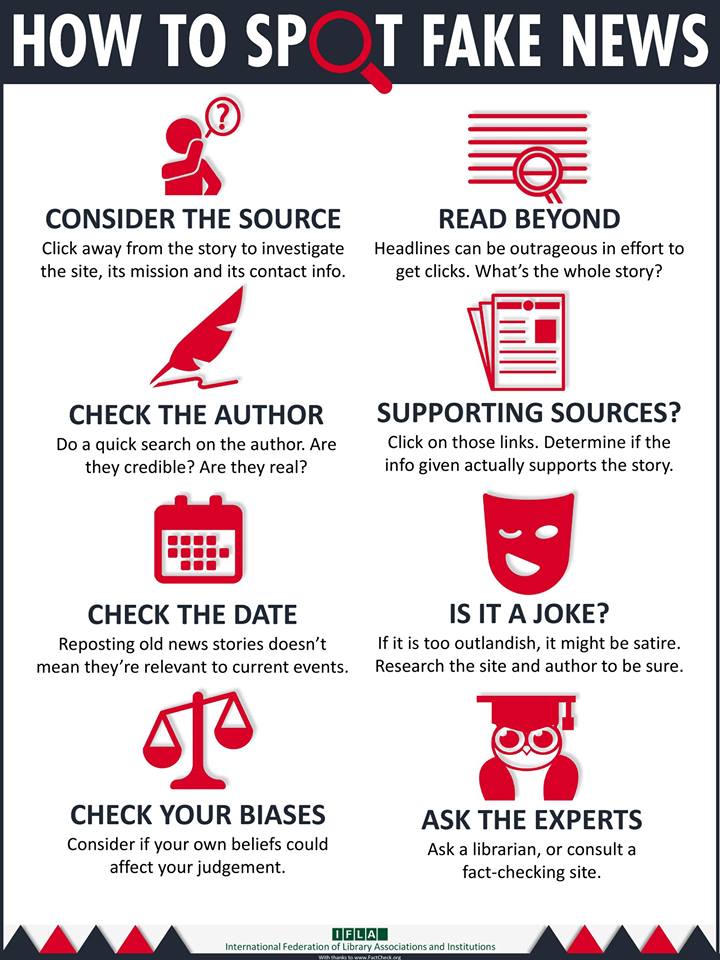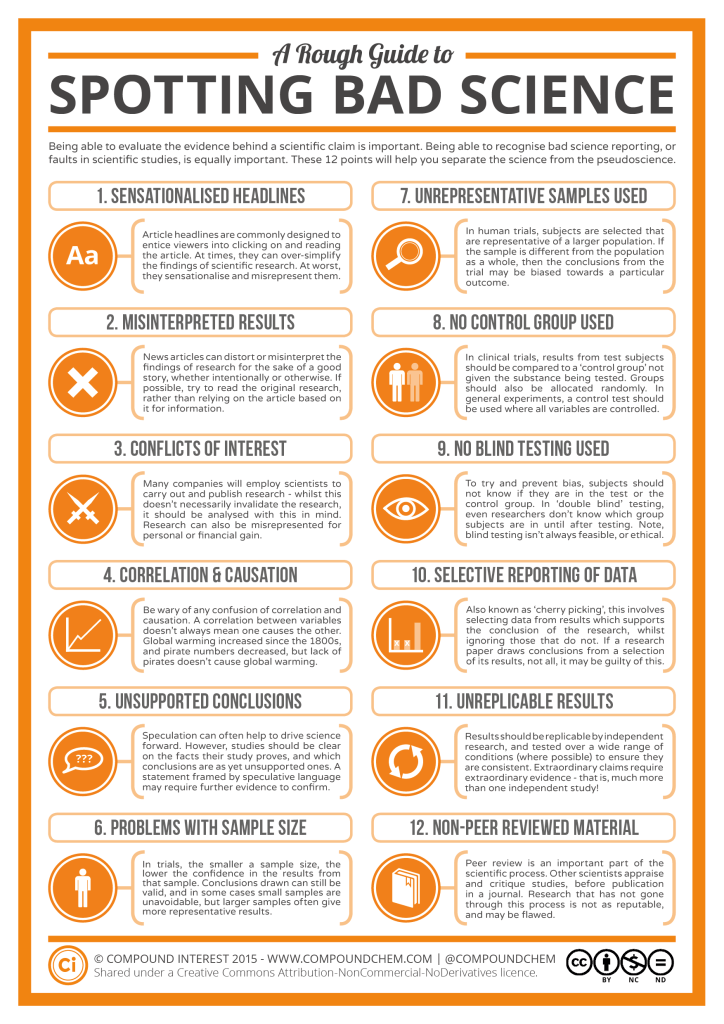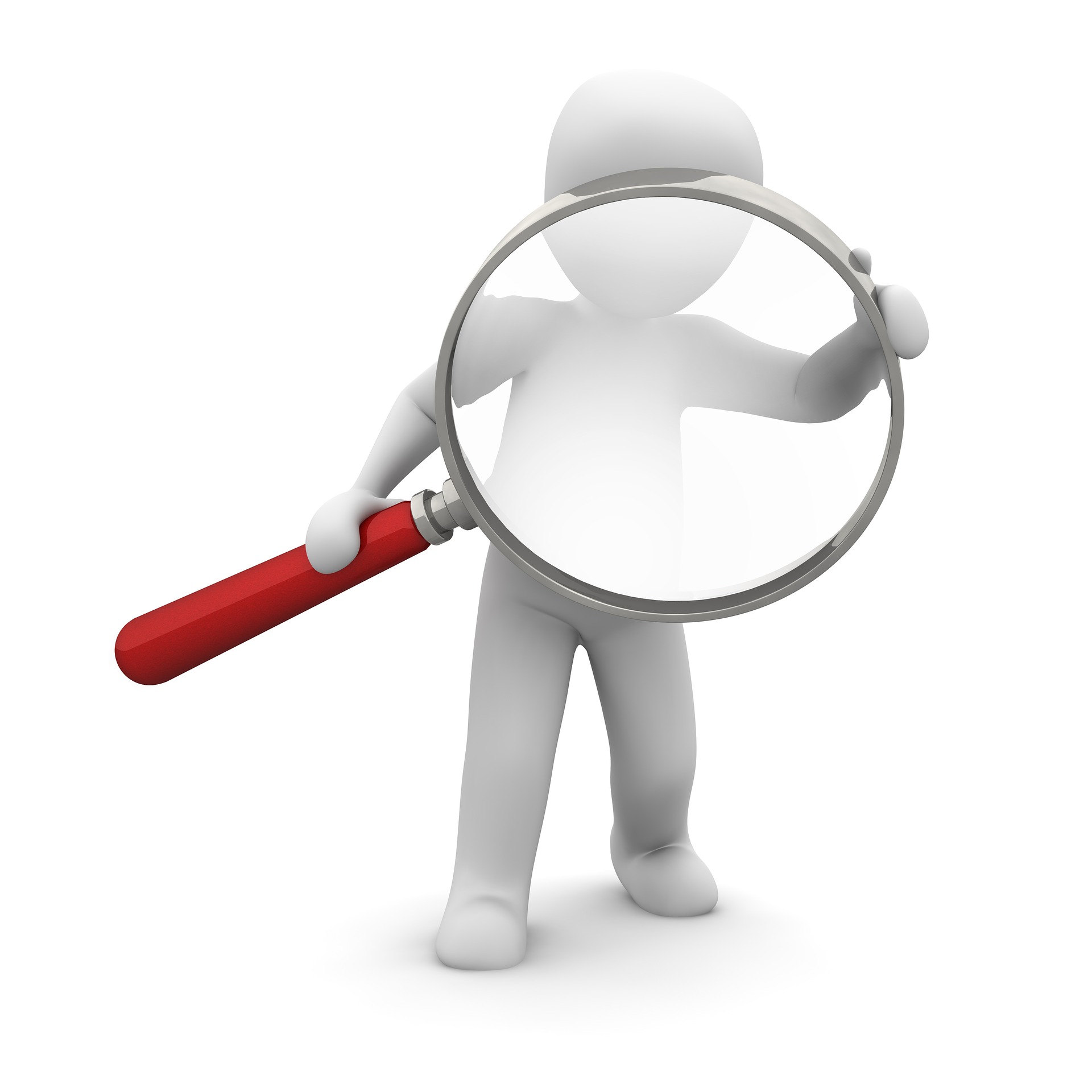Fake News
The Basics
Did your mother call you to tell you that liberals hate science? Did your Facebook feed pop up with an article on a new pesticide that’s going to kill us all? Did one of your friends breathlessly tell you that president Donald Trump was going to pardon mass shooter Dylann Roof? You might have heard any or all of these stories, but there’s one thread connecting all of them: they’re not true.
The ability to tell accurate news from fake news is an important skill that you’ll use for the rest of your life. This LibGuide will give you valuable insight in telling fact from fiction online, plus a chance to exercise your newfound skills.
This guide will explain the differences between “fake news,” satire, bias and opinion, as well as different types of fake news. It will also give you the skills to critically examine news stories, science reporting, and various types of images.
There are four broad categories of fake news, according to media professor Melissa Zimdars of Merrimack College.
CATEGORY 1: Fake, false, or regularly misleading websites that are shared on Facebook and social media. Some of these websites may rely on “outrage” by using distorted headlines and decontextualized or dubious information in order to generate likes, shares, and profits.
CATEGORY 2: Websites that may circulate misleading and/or potentially unreliable information
CATEGORY 3: Websites which sometimes use clickbait-y headlines and social media descriptions
CATEGORY 4: Satire/comedy sites, which can offer important critical commentary on politics and society, but have the potential to be shared as actual/literal news
No single topic falls under a single category – for example, false or misleading medical news may be entirely fabricated (Category 1), may intentionally misinterpret facts or misrepresent data (Category 2), may be accurate or partially accurate but use an alarmist title to get your attention (Category 3) or may be a critique on modern medical practice (Category 4.) Some articles fall under more than one category. Assessing the quality of the content is crucial to understanding whether what you are viewing is true or not. It is up to you to do the legwork to make sure your information is good.
Fake news, bias, opinion and satire can be closely related and can coexist within the same story, but can also be different. It is important to understand and consider all four when evaluating any source of information.
- Fake News
- As discussed in the section on “Types of Fake News,” true fake news is false or misleading information written or shared with the intent of misleading the audience. Bias and opinion can play a role in the creation of fake news, but are also important to consider in traditional news sources as well.
- Bias
- News can be biased without being fake, but you should always consider the potential bias or agenda in any source you are using, especially if it is not written by an expert. If a source is too biased, you may want to consider whether it crosses the line into “fake” news.
- Consider not only the bias of the source, but your own biases as well – we all have them! Do your pre-existing beliefs lead you to want to believe or disbelieve the story? If so, this is confirmation bias. Make sure you consider how your confirmation bias affects your ability to view the story objectively, and make sure you look for objective ways to verify or disprove the story.
- Opinion
- Be watchful of using items that appear in the opinion section of a newspaper or magazine as fact. Opinion sections are generally separate from the news, and may range from expert opinions on a topic to lay opinions. If you are going to use an opinion, make sure you understand who wrote the opinion piece, what expertise (if any) makes their opinion worth using, and what bias or agenda they might have.
- Satire
- Dictionary.com defines satire as 1) the use of irony, sarcasm, ridicule or the link in exposing, denouncing or deriding vice, folly, etc.; 2) a literary composition, in verse or prose, in which human folly and vice are held up to scorn, derision, or ridicule; or 3) a literary genre comprising such compositions.
- As discussed in the section on “Types of Fake News,” satire is generally not intended to be taken seriously, but can cause problems if it is inadvertently shared as real news, or a reader doesn’t realize it is satire.
History
Although “fake news” has been getting a lot of attention recently, the problem isn’t really a new one.

© The Yellow Press by LM Glackens, Published by Keppler & Schwarzmann, 1910 – From the Library of Congress
Yellow Journalism was the term used to refer to a newspaper that emphasized sensationalism over facts in the late 1800s. As depicted in the image above, yellow journalism focused on appeals to emotions and sensationalism. For a history of yellow journalism, visit the State Department’s page.

© Image from Roads Publishing
“Tabloid journalism” is another form of fake news many of us are familiar with. Tabloid journalism refers to a sensationalistic and deliberately false reporting. For more information on tabloid journalism, see voiceseducation.org.
- Propaganda
- Yellow journalism
- Penny Press
- Tabloid journalism
- Spurious news
- False news
- Hoax
- Disinformation
- Clickbait
New York Sun’s Great Moon Hoax
This series of stories appeared in 1835, claiming that an astronomer had found evidence of life on the moon, including unicorns and humanoid bats.
War of the Worlds Broadcast
Orson Wells caused panic in 1938 with a broadcast of “War of the Worlds,” a radio dramatization of a Martian invasion of Earth.
AIDS Disinformation Campaign
In 1983 the Soviet Bloc spread a story that the United States’ had created the AIDS epidemic through medical experiments.
The Spanish American War
During the 1890s, Yellow Journalism sensationalized and even made up events to inflame public opinion, eventually helping push the United States into war.
Nazi Blood Libel
From the Middle Ages to Nazi Germany, various groups have used propaganda to accuse Jewish people of ritual murder.
Fact Checking
- Read the whole article, not just the headline
- Check the authority of the source(s)
- Read multiple sources
- Avoid confirmation bias
- Follow the story as new stories are posted
- Think & check before you share!
- Above all – think critically & ask questions!
- Be skeptical.
- Look for disclaimers, such as “for entertainment” or “satire”
- Use of provably inaccurate facts
- Use of adjectives or adverbs to “pump up” a source’s credibility
- Is too far “right” or too far “left”
- Uses fear-mongering or hate
- Does not have an actual “byline” (author)
- If there is a byline, does it link to a page of the author’s work or a biography of the author?
- Check the story for the number of attributes they contain and named sources
- Does it use pictures without captions or photo credits?
- Does it misrepresent a photo or use it out of context?
- Independent
- Independent Sources are better than Self-Interested Sources
- Multiple
- Multiple Sources are Better than a Single Source
- Verify
- Sources who Verify with Evidence are Better than Sources who Assert
- Authoritative & Informed
- Authoritative/Informed Sources are Better than Uninformed Sources
- Named
- Named Sources are Better than Uninformed Sources
Borrowed from Stony Brook Center for News Literacy
- Avoids all the pitfalls discussed under “red flags”
- The author or organization follows the story and provides more information as it becomes available
- ‘Fake news’ is often a one-off
- Even “real news” makes mistakes – but they correct them!
- Journalists seek the best obtainable version of the truth they can get at the time
- Good news is like science – it changes and evolves with new information
- Here is an example of reporting on the Titanic disaster that was full of mistakes due to incomplete information available at the time. Does this make it “fake news?” Does it matter whether the mistakes are intentional? Does it matter whether they are later corrected?
- Answers the question: Says who?
- Puts facts in context and gives background
- The story is transparent – it allows you to track the reporter’s work
- You can tell the reporter verified the information
- Identifies sources, or tells you why they can’t be identified
- Follows professional standards
News Outlet Codes of Ethics and Standards
One of the ways in which a news source demonstrates its authenticity and responsibility to its readers is through a publicly accessible code of ethics or standards. A sample of various codes, mission statements and ethics handbooks are listed below.
In this section we’ll examine two sample stories; one that could be considered “fake news,” and another more reliable story, using some of the concepts addressed earlier in this guide.
NOTE: To see larger images, right click and select “Open Image in New Tab.”
How Should We Evaluate This Website?
This website claims that the earth is hollow: http://www.trinfinity8.com/mission-to-inner-earth-is-it-really-hollow/

From: http://iue.libguides.com/fakenews/claim
How Should We Evaluate This Website?
Analysis of a New York Times story.





Known Fake News Sites
The Daily Dot: Fake News Sites List
NOTE: This list is not exhaustive and may be updated at any time. A compiled list of fake news sites to watch out for.
List of Fake and Parody News
Professor Zimdars’ original list and criteria, with updates and addenda.
The Onion
One of America’s premier parodic news sites.
The Borowitz Report
From humorist Andy Borowitz, a column parodizing and commenting on current news trends
Dr. Joseph Mercola
Mercola is a doctor of osteopathy who has frequently been targeted by the FDA for promoting false, misleading and even dangerous medical advice. His site promotes products and his blog includes false and/or misleading information about medical topics.
Play a Game!
Quick Debunking Exercise:
Compare these two links. Which one do you think is true?
1 – Eat This Not That: Shocking Facts About Farmed Salmon
2 – Washington State Department of Health: Farmed vs. Wild Salmon
Choose a Claim to Examine
Can you answer the questions?
Example Websites
The following websites are examples of fake sites created to show how easy it is to create a convincing fake website.
Science
Science Reporting
While reading science news, you still want to think about all of the general principles discussed throughout this guide. However, there are also some extra issues you want to consider when reading news reports about science or scientific studies. Keep in mind that the news reporter is usually not an expert in the field, so you want to look at the story with the skeptical eye of an expert.
Causation v. Correlation
Causation and correlation are not the same thing; you can have a correlation without having causation. Check out “The Danger of Mixing Up Causation & Correlation” TED Talk with Ionica Smeets to see how this works (above).
Other Examples of Correlation without Causation
- Spurious Correlations was a project Tyler Vigen put together as a fun way to look at correlations and to think about data.

From: © http://www.compoundchem.com/2014/04/02/a-rough-guide-to-spotting-bad-science/
Images, Graphics & Photos
Images, graphics and photos also raise some unique issues and potential problems for the unwary reader. This page will help you learn how to spot problematic media and think about the images and graphics you see critically.
We often think of numbers, charts and graphs as being great sources of information because they are so clear. However, charts and graphics can be misleading as well. See these examples from the National Geographic:

From the © National Geographic, https://news.nationalgeographic.com/2015/06/150619-data-points-five-ways-to-lie-with-charts/
This chart demonstrates that changing the scale on a chart or graph can change how dramatic the numbers appear to the reader.

From the © National Geographic, https://news.nationalgeographic.com/2015/06/150619-data-points-five-ways-to-lie-with-charts/
This chart demonstrates how statistics may appear to be misleading if they are not controlled for other factors, such as population size.
For other ways charts and graphs can be misleading, see the National Geographic story.
Contextual misrepresentation of a photo is when a real photo is used in the wrong context.
For example, the following photo was used in a Ukranian news story, allegedly showing Russian forces entering Ukraine in 2014. However, the photo was really an Associated Press photo of Russian forces taken in 2008 as they headed to the border with Georgia – not Ukraine.

From the Times Union Picture Prosecutor’s blog: http://blog.timesunion.com/pictureprosecutor/case-11-ap-photo-is-off-by-6-years-and-550-miles-in-contextual-misuse-by-ukraine-investigation-site/822/
Unfortunately, this and other misrepresented photos were actually used by a Senator in his attempt to introduce a bill in the US Senate! For more information on this photo, see the “Picture Prosecutor’s” story. Other examples of misused photos are available on his blog.
If you see an image and it seems unlikely to be real, do some investigating! If an image seems unlikely to be real, it probably is.

Credit: © Elena Vizerskaya,,http://www.gettyimages.com/license/182062392
This photo made the rounds on the internet and social media, allegedly showing a seal and a Beluga whale hugging. Skeptical? You should be. A little digging reveals the image was digital art created by artist Elena Vizerskaya. For more information on this image, see the Science Alert article.
Resources
Attempts to Fight ‘Fake News’
Checking “News Stories”
Checking Images
 This work is licensed under a Creative Commons Attribution-NonCommercial 4.0 International License.
This work is licensed under a Creative Commons Attribution-NonCommercial 4.0 International License.
Indiana University East Campus Library Fake News guide was used for some of the content in this guide.

